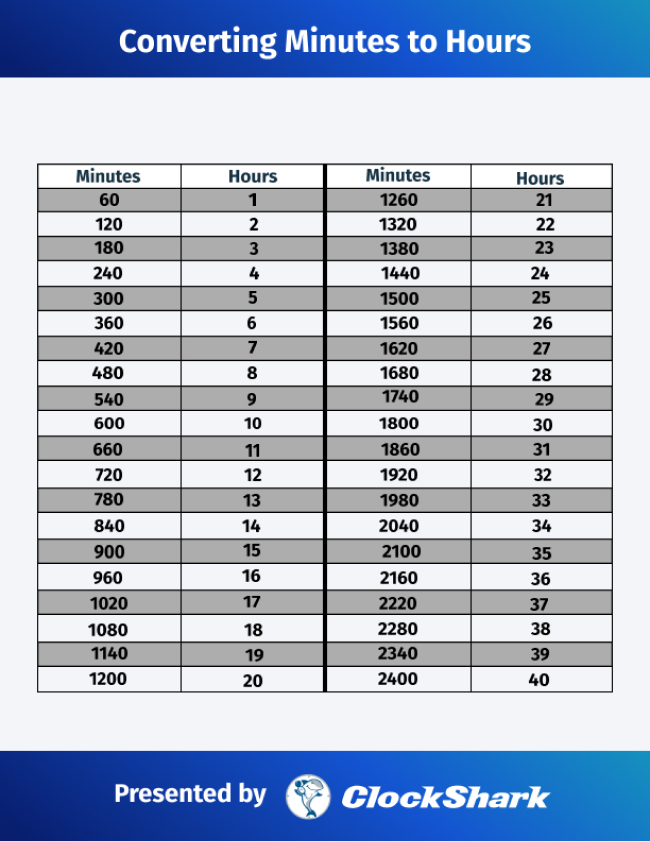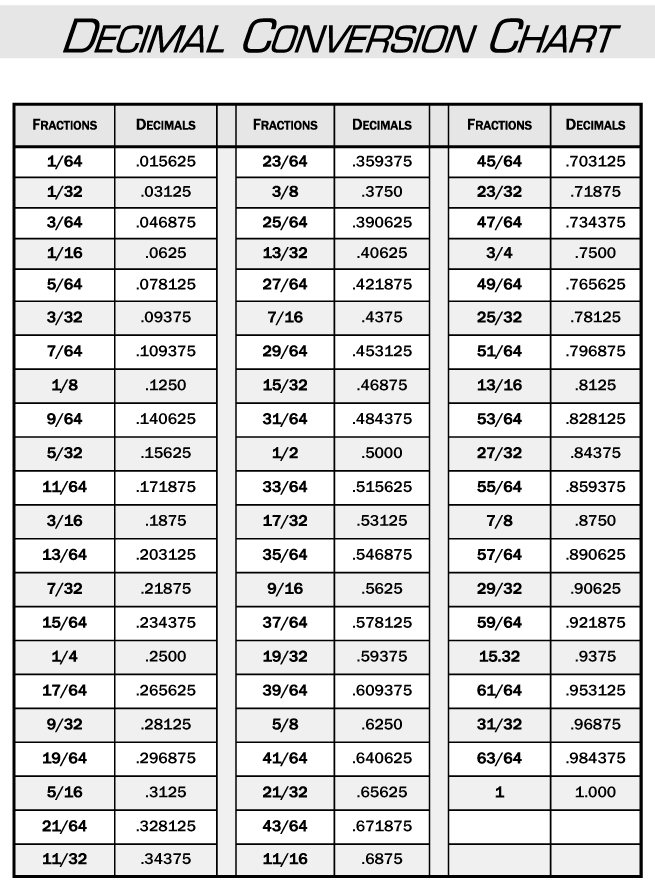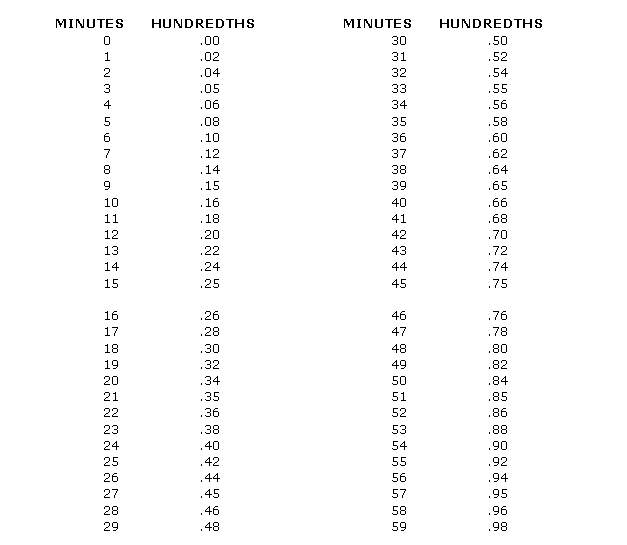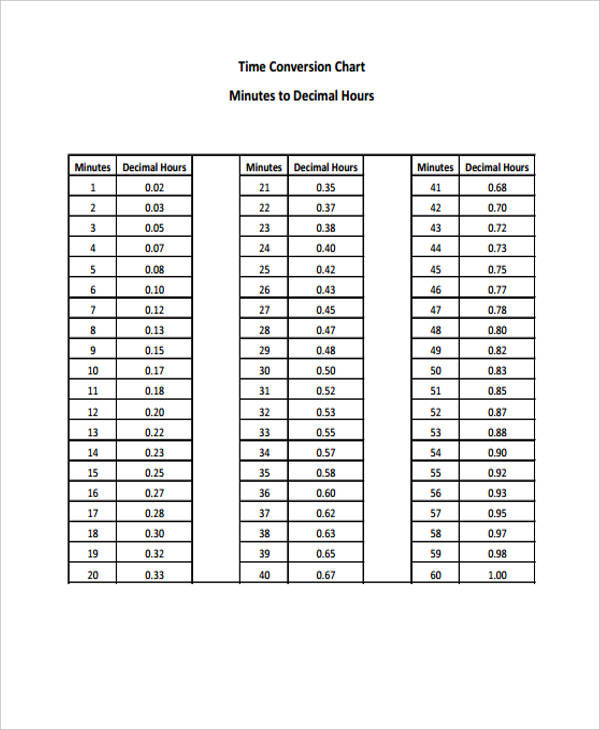There is more to converting hours and minutes to decimals than simply adding a period between those hours and minutes. For example, if your employee works 40 hours and 23 minutes one week, you can't multiply 40.23 by the hourly pay to get the correct wage. Instead, the minutes must be converted to decimals.
Converting minutes to decimals is simple enough by dividing the minutes by 60. See our quick minutes to decimal conversion chart below. While paying employees sounds simple, the process can get complicated. This is especially true for owners of very small businesses who run payroll manually.
When you run payroll by hand, you typically have to convert employee timesheets to decimals to calculate wages. Converting minutes to decimals can be tedious work, which is why we've included a payroll conversion chart in this article. With a payroll conversion chart, you can quickly figure out minute to decimal conversions and improve accuracy when you run payroll. Quickly convert hours and minutes to decimals with our time clock conversionfor payroll chart. Accurate payroll requires tracking the hours your employees work, and converting those hours to dollars and cents. The whole process gets a little trickier when you have to translate the hours and minutes to decimals.
Many people hate math and all of its evil cousins, such as algebra, calculus and decimals. While one may argue that the real life practical use of the first two is non-existent, it's hard to be a business owner and not come across decimals on a frequent basis. This is especially true for the wise service-oriented business owners who use an online clock in, clock out system to capture accurate time for their remote hourly employees. To be sure you're not over or underpaying your employees, you must convert minutes worked into decimals.
To perform the conversion, you can use payroll software like Gusto, an online time calculator, free minute conversion chart or a Google Sheets Minute Conversion Template. If you are an employer with multiple hourly workers, it can be challenging to calculate pay if they work only a fraction of an hour. To pay employees working for partial hours, you need to know how to convert minutes for payroll. Failing to convert minutes when calculating pay causes errors and creates more work on the back-end.
However, it's simple if you know how to express minutes as decimals. Once time worked is converted into decimal form, such as 4.35 hours, you can multiply by the pay rate and find total wages due. Time clock conversion means converting your employees' work hours and minutes into decimals—in order to calculate their salaries. Here's an hours calculator you can use to do just that.
Just enter times from your employees' time cards on the left to get the decimal hours on the right. To calculate the actual time worked, you need to total the hours and minutes between your employee's starting and ending times for each workday. The timesheet below provides a good example of the information you'll start with before converting minutes to decimal form.
Playing around with time values, like adding them, subtracting them is not as simple as it looks, especially, when we are dealing with regular time in AM/PM format. We have to take care of many details like hours and minutes and day and night. Such calculations become more confusing when you have a load of calculating salaries through AM/PM time card of your several employees. A single mistake may add an extra burden to the business's finance. Use this simple Minutes to Decimals Conversion Chart to easily identify the correct decimal value for each unit of payroll time, a necessary step when processing payroll. When using payroll software, like Payentry, you must first convert minutes to decimals.
Converting minutes to decimals is as simple as dividing minutes by 60. The good news is you can skip that step if you use our minute conversion chart. In the chart, simply find the minutes worked, between one and 60, and the decimal equivalent will be to its immediate right. Once you have the decimal, add it to the number of hours worked.
Converting employee hours from minutes to decimals is one part of a very complex process. With so many considerations and regulations, payroll processing and payroll tax preparation are often outsourced to a payroll bureau. Payroll Management, Inc. was founded in 1989 and now serves businesses across Maine and New England with local, personalized service. Maybe the time is right to talk with us about your payroll. Are you interested in how time is properly converted from hours and minutes to decimal format for payroll?
We'll review and compare these two common formats for displaying and expressing time. It would be very desirable that all divisions, for example of the livre, the sou, the toise, the day, the hour, etc. would be from tens into tens. Further, the new tierce would be divided into 1000 quatierces, which he called "microscopic points of time". He also suggested a week of 10 days and dividing the year into 10 "solar months". Oftentimes, business owners using a manual payroll process have to convert the hours an employee worked into decimals. This can make it easier to calculate an employee's gross pay.
But those conversions can be tricky and open the door for all sorts of possible calculation errors. Your employees can use our time tracking software to seamlessly log their hours. The data is then automatically fed to payroll, so you don't need to worry about time clock conversion or timesheet calculators. Just type in the hours and minutes below and our free time card calculator will automatically convert that to decimals for you.
In the two examples we just reviewed, the difference between converting minutes to decimals the wrong way versus the right way is that you short pay an employee for $3.52. This is a very easy to use hours to minutes converter. Minutes value will be converted automatically as you type. Another common type of decimal time is decimal hours. In 1896, Henri de Sarrauton of the Oran Geographical Society proposed dividing the 24 hours of the day each into 100 decimal minutes, and each minute into 100 decimal seconds.
Although endorsed by the Bureau des Longitudes, this proposal failed, but using decimal fractions of an hour to represent the time of day instead of minutes has become common. Besides turning hours and minutes into decimal hours, you may also need to convert time from the 24-hour clock to the 12-hour format (am/pm). This is necessary if your employee time cards are set to the 24-hour format, for example. Contrary to what some find difficult, converting minutes for payroll is easy. It just depends on whether you use rounded or actual hours worked, how you track working hours, and what tools you use to calculate. Your main goal is to translate time worked into decimal form, so you can multiply by your employee's pay rate and find how much you owe in wages.
In today's decimal world, often there is the need to convert between "standard" hours, minutes & seconds and decimal time. This can be particularly useful in the workplace where clocking in machines are used, many of which use decimal time. If the clock machine stops working due to power failure, lack of ink or incorrect timing, you may find yourself needing to calculate the decimal time yourself.
Our quick online converter will take the stress out of your conversion needs. Here are short and long conversion charts for minutes to decimal hours which can help people who are entering hours in hours and minutes. Time can be expressed either as fractions, decimals, or as minutes and hours. In order to calculate payroll, time needs to be in decimal form so that it can be multiplied by an employee's pay rate.
You can run payroll by hand, use payroll software, or outsource your payroll process to an accountant or payroll provider. Manually running payroll is an inexpensive option, although it can quickly get overwhelming. Use our decimals conversion chart as an easy reference tool as you run payroll. For example, let's say an employee works 27 hours and 14 minutes in a week. What does that number come out to as a decimal value?
To get the answer, you have to divide the total number of minutes by 60. To get gross pay, you multiply that figure by the employee's hourly pay rate. As you can imagine, doing this for every employee can get tedious. And entering even a single wrong number can result in an incorrect paycheck. Manually converting employee hours and minutes to decimal values is time-consuming and prone to errors. If your time clock tracks hours worked to the minute, use this chart to convert minutes to decimal for Banner time entry.
The tutorial demonstrates different ways to convert time to decimal in Excel. You will find a variety of formulas to change time to hours, minutes or seconds as well as convert text to time and vice versa. If you don't want to use a conversion calculator , another basic tool is a decimal conversion chart. When you have to turn, say, 17 hours and 25 minutes in decimals, you can easily check the conversion table and see that this equals 17.42 hours.
Usually you get records of employees' time worked in hours and minutes. But hours and minutes aren't directly equal to money owed. You need to convert time into decimal numbers to figure out your employees' exact pay rate. If you do not like to remember formulas, you can use Convert Time utility of Kutools for Excel to convert time to decimal hours or minutes or seconds by a click. Now you're ready to use the time you converted into decimal form to calculate how much you need to pay your employee.
The differences that arise with rounding your employees' working hours can add up over time. In our example, it was in the employee's favor, which meant you would be paying for more time than was actually worked. Our online tools will provide quick answers to your calculation and conversion needs. On this page, you can convert time values specified in hours, minutes and seconds to decimal hours and vice-versa. We also have a time card calculator that allows you to enter an entire week of in and out times.
It then auto calculates the hours, including lunch and overtime. Of if you want to completely automate time, check out employee time tracking by OnTheClock. We have been using ClockInEasy for over a year now and I highly recommend it to any business owner. It has saved our company countless hours of keying timesheet data and was very easy to set up with our payroll provider. We used to spend almost a day doing payroll each week and now it takes us less than an 1 hour. Use the chart below to convert minutes worked into hundredths or quarters of an hour for entering hours worked information.
For example, 8.38 would be the entry for a day during which an employee worked 8 hours and 23 minutes. Some decimal time proposals are based upon alternate units of metric time. Just as standard time uses the metric time unit of the second as its basis, proposed decimal time scales may use alternative metric units. If manual payroll just seems too overwhelming, then you might consider using payroll software or a payroll provider. Many small businesses eventually turn to these payroll solutions as they grow their teams.
That's because payroll software can automate the payroll process while giving you more accurate results. This frees up time for you to focus on the aspects of your business you're most interested in. To learn more about the payroll process and view our payroll conversion chart, keep reading. You can also skip right to the payroll time conversion chart or any other section using the links below.
First, you have to take the information from her weekly time card or timesheet that contains her clock-in and clock-out times (psssst....free timecard templates here). Then you need to multiply the number of hours she worked by her hourly rate to determine her weekly total pay. Enter the hours, minutes, and seconds of your time, and it will display the decimal values for hours, minutes, and seconds. Read on you find out how to calculate time in decimals manually. Our free minute conversion chart will show you the corresponding decimal for minutes one through 60 to help you calculate gross pay accurately and quickly based on actual hours worked.
An online converter to change from decimal hours to hours minutes seconds. I know I'm asking a lot here but could you explain how to convert "Duration in seconds " to a readable format of years,months,weeks,days,seconds in Excel? I see all sorts of ways to convert date to date, etc but not "duration" of time in seconds! I need a way to convert it into a readable format of years, months, weeks, days, hours and seconds. I can do it in Perl, C and others but not in Excell. As you see, the formulas with cell references and corresponding text strings deliver identical results.
Also, please notice the left alignment of time strings in cells A2 and A6 and right-aligned converted time values in column D. In general, there are two ways to convert time to decimal in Excel - by changing the cell format and by using arithmetic calculations or Excel time functions, such as HOUR, MINUTE and SECOND. Further on in this tutorial, you will find the detailed explanation of the first way and formula examples demonstrating the other technique. Working with Time in Microsoft Excel | Time Functions and Conversion Do you need to add or subtract time in Excel? Some time calculations are easy, but depending on how the time is entered, you may need to use the TIME function or formula to add or subtract time. For example, if you have 9am in B2, and in cell C2, you have 3, for three hours, you can't add them with B2+C2 and get the correct answer without the TIME function.
For example, decimal days divide the day into 10 equal parts, and decimal years divide the year into 10 equal parts. Decimals are easier to plot than both minutes and seconds, which uses the sexagesimal numbering system, hours, months and days, which has irregular month lengths. In astronomy, the so-called Julian day uses decimal days centered on Greenwich noon. The Toulouse Chamber of Commerce adopted a resolution supporting his proposal in April 1897.
Although widely published, the proposal received little backing. Gusto tracks employee time and attendance and automatically processes payroll without performing any manual calculations. Employees can clock in and out from their mobile devices and even monitor hours spent on projects to get a detailed cost report of wages, taxes, and more. Most of the work in this formula is done by the TEXT function, which applies a custom number format for hours and minutes to a value created by subtracting the start date from the end date. In payroll calculations, you need to multiply the employee's pay rate by the decimal form. If you're tracking your employee's time in Timesheets.com, you'll see both the numbers on the timesheet and just the decimal numbers on reports.
If you want to learn a few more helpful formulas to add and subtract times, calculate elapsed time and time difference, please check out other parts of our Excel Times tutorial . I thank you for reading and hope to see you again next week. You can also check the hours to minutes conversion chart below, or go back to hours to minutes converter to top. Time to Decimal Hours Calculator can convert your 24-Hours format time having hours, minutes and seconds into decimal hours instantly. Payroll software is a technological solution to running payroll.






















No comments:
Post a Comment
Note: Only a member of this blog may post a comment.